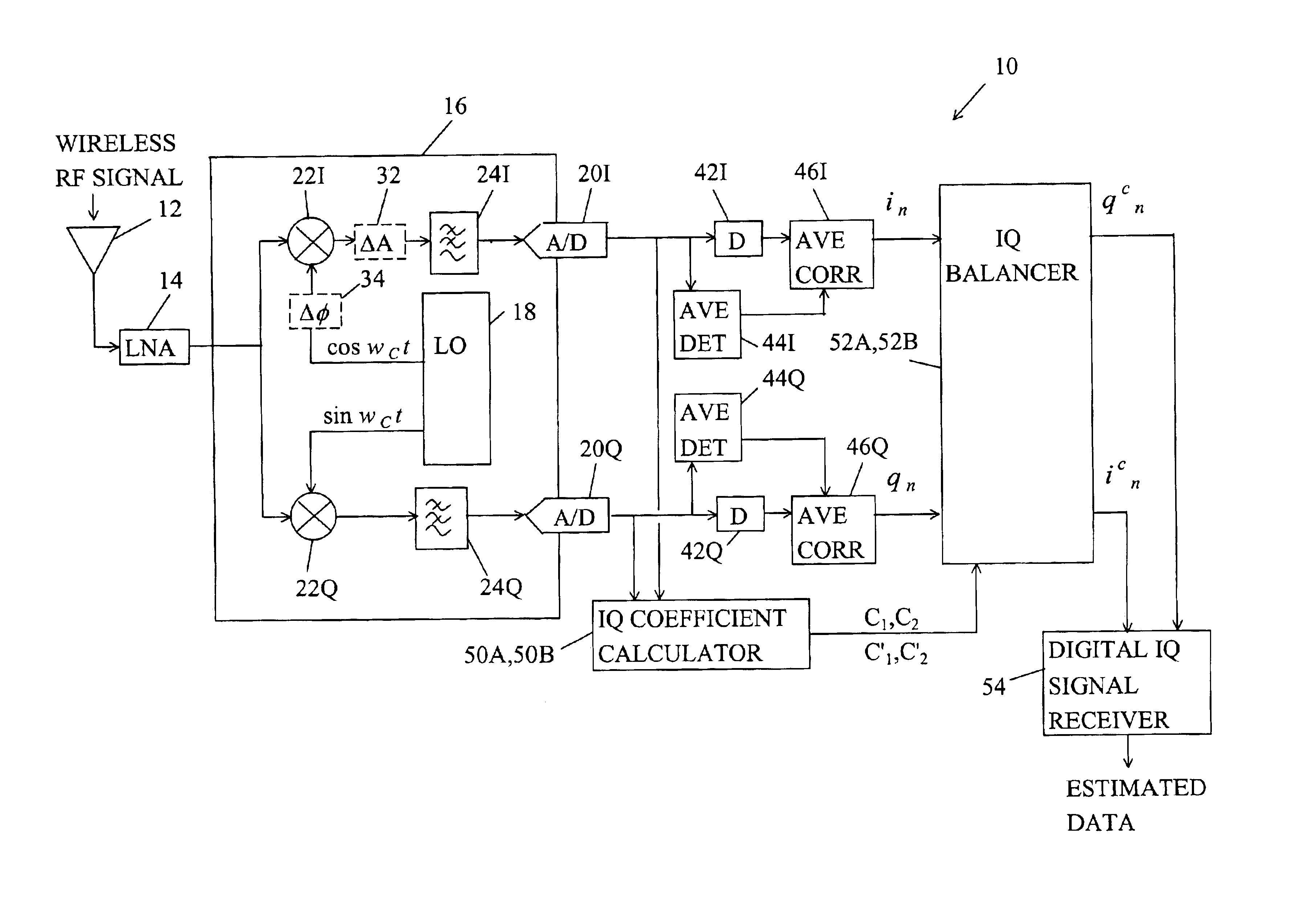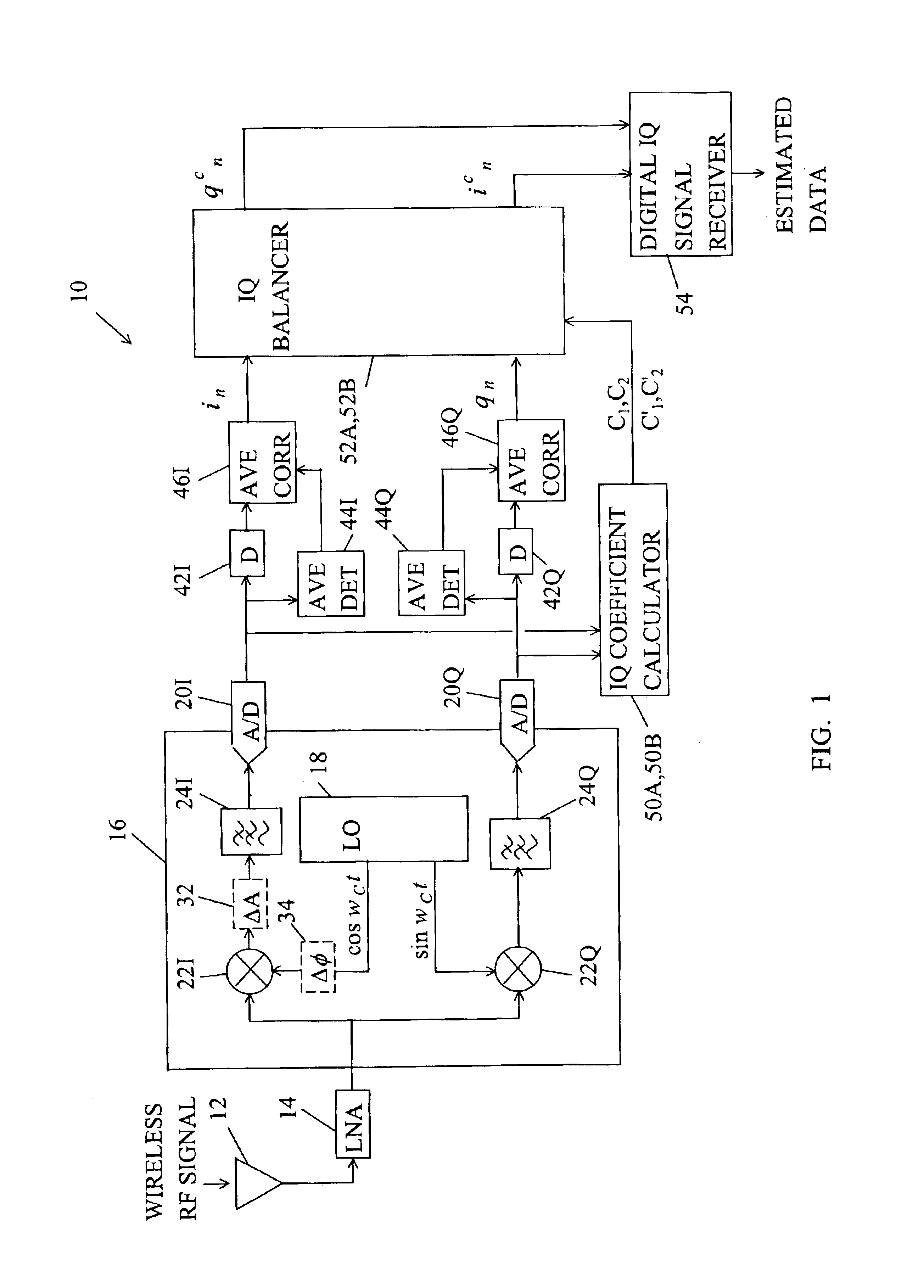Receiver having automatic burst mode I/Q gain and phase balance
a receiver and burst mode technology, applied in the field of balancing i/q gain and i/q phase in a signal receiver, can solve the problems of i/q gain and i/q phase to be out of balance, the bit error rate (ber) in estimating the transmitted data is affected, and the performance of the receiver using the test signal method is limited
- Summary
- Abstract
- Description
- Claims
- Application Information
AI Technical Summary
Benefits of technology
Problems solved by technology
Method used
Image
Examples
second embodiment
[0027]Similarly, the second embodiment IQ corrector 52B includes a phase balancer 62B, a summer 64B, and a gain balancer 66B. The phase balancer 62B multiplies the Q signal qn by the second coefficient C′2 and provides a phase correction signal C′2*qn to the summer 64B. The gain balancer 66B multiplies the I signal in by the first coefficient C′1 and provides an amplitude correction signal C′1*in to the summer 64B. The summer 64B adds the phase correction signal C′2*qn to the amplitude correction digital C′1*in and provides the corrected I signal icn=C′1*in+C′2*qn as the sum. The Q signal qn is passed straight through as the corrected Q signal qcn. Of course, the processing of the I and Q signals in and qn could be exchanged.
[0028]Simple algorithms for computing the correction coefficients in the IQ coefficient calculator 50A,B are described with the aid of equations 5-12. K1=∑n=1Ninqn(5)K2=∑n=1Nqnqn(6)K3=K1K2(7)K4=∑n=1Nqn(8)K5=∑n=1Nin-K3qn(9)C1=C1′=K4K5(10) C2=−K3 (11)
C′2=−...
first embodiment
[0030]For the first embodiment where the IQ balancer 52A corrects I and Q signals according to icn=C1*(C2*qn+in) and qcn=qn, the IQ coefficient calculator 50A computes the first correction coefficient C, equal to the fourth term K4 divided by the fifth term K5 and computes the second correction coefficient C2 equal to the negative of the third term K3.
[0031]For the second embodiment where the IQ balancer 52B corrects the I and Q signals according to icn=C′1*in+C′2*qn and qcn=qn, the coefficient calculator 50B computes the first correction coefficient C′1 equal to the fourth term K4 divided by the fifth term K5 and computes the second correction coefficient C′2 equal to the negative of the product of the first coefficient C′1 times the third term K3.
[0032]It should be understood that it is equivalent to exchange the processing of the in and qn vectors for the equivalent result in the first embodiment and in the second embodiment.
PUM
 Login to View More
Login to View More Abstract
Description
Claims
Application Information
 Login to View More
Login to View More - R&D
- Intellectual Property
- Life Sciences
- Materials
- Tech Scout
- Unparalleled Data Quality
- Higher Quality Content
- 60% Fewer Hallucinations
Browse by: Latest US Patents, China's latest patents, Technical Efficacy Thesaurus, Application Domain, Technology Topic, Popular Technical Reports.
© 2025 PatSnap. All rights reserved.Legal|Privacy policy|Modern Slavery Act Transparency Statement|Sitemap|About US| Contact US: help@patsnap.com



